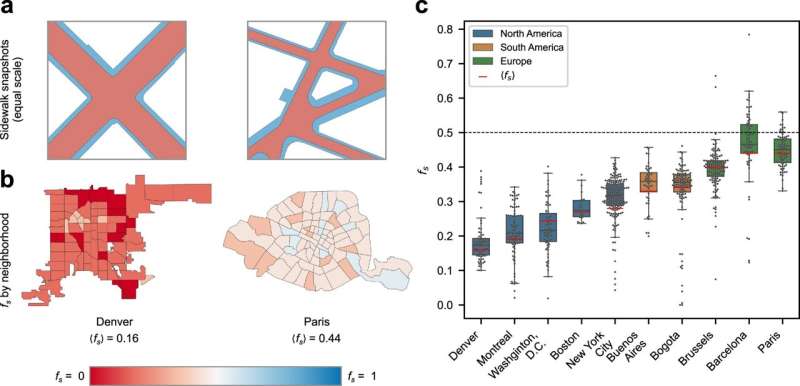Fig. 1: Maps and statistics on arrogance of space. The distribution of street space between cars and pedestrians varies widely both within and among cities, but is everywhere biased towards cars. a Close-up snapshots representing the area for motor vehicles (red) and sidewalks (blue). White area corresponds to buildings. Clear to the naked eye, the majority of street space is devoted to cars. b A more general view of the cities under scrutiny confirms indeed that roads take up most of the space. Only Paris presents a few districts where the sidewalk share of street space fs is above 50%. c Box plots (median in dark gray) displaying the distribution of space for all the cities for which the sidewalk geometries were gathered. The x-axis is sorted from lowest to highest average sidewalk share, 〈fs〉 marked in red. Interestingly, none of the cities achieve a median (nor average) fs of 50% or higher. In general, cities present a remarkable internal heterogeneity, which implies that some districts (dots) suffer from a double inequity (with respect to cars, and also with respect to other areas of the city). It is clear that European cities rank best in the plot, possibly because they typically have larger “historical centers,” where street space tends to be shared. Credit: DOI: 10.1038/s42005-021-00688-z
In response to the COVID-19 pandemic, many cities are joining the trend towards providing more space for pedestrians. The current health crisis has put the spotlight on how we use public spaces and some towns and cities have extended pedestrian zones in order to facilitate social distancing and prevent contagion. Some roads have also been closed to traffic, but there was formerly no scientific method to help authorities make this kind of decision.
A research team from the Universitat Oberta de Catalunya (UOC) and the University of California, Berkeley in the US has developed just such a method. Having measured how space is distributed between roads and pavements in 10 cities in three continents using, for the first time, automated technology, the scientists designed a methodology for determining what measures should be taken to ensure greater distancing between pedestrians.
"If you don't take any measures in cities, it is not possible to have a pedestrian system that allows social distancing," explained Daniel Rhoads, Albert Solé, professor at the Faculty of Computer Science, Multimedia and Telecommunications, and Javier Borge-Holthoefer, members of the CoSIN3 research group at the UOC's Internet Interdisciplinary Institute (IN3) and co-authors of the study published in the scientific journal Communications Physics.
The cities studied were Denver, Montreal, Washington D.C., Boston and New York in North America; Buenos Aires and Bogotá in South America; and in Europe, Brussels, Barcelona and Paris.
"Our methodology shows that, with a well-planned strategy, the effort required to improve the pavement system in a city can be shared, while still allowing traffic to circulate," said the researchers. Thanks to an algorithm that the team has developed, the cost of maintaining this pavement network can be shared between pedestrians and drivers.
According to Borge-Holthoefer, leader of the CoSIN3 group, European cities do best at achieving this balance, thanks to their layout, while it is most difficult to achieve in US cities.
The difference between Barcelona and New York
The researchers use the term open streets, which as Borge-Holthoefer stated "has come to be used widely in the English-speaking media to refer, above all, to closing streets to traffic and freeing them up for pedestrians and non-motorized traffic, such as cyclists and skaters." It also includes other measures such as widening seating areas for bars and restaurants and providing more space for children's play areas.
To measure the space dedicated to pedestrians and traffic, the researchers used the public geographic information system (GIS) data generally hosted on city authorities' open data portals.
The ten cities were chosen taking into account the availability of these data, selecting cities on different continents to allow for comparisons. The study shows that city planning, in most cases, leaves little space for pedestrians to walk. "Public space is distributed in a way that is 'unfair' or 'arrogant,' as our study shows," said Borge-Holthoefer.
When comparing European, North American and South American cities, the researchers found that the fairest cities are in Europe. The cities that allow least space for pedestrians are in the United States, while the South American cities fell between the two extremes.
In Barcelona, for example, pavements occupy almost half the public space available, while in New York the figure is just 28%. In general, city centers provide more space for pedestrians and this decreases in favor of vehicles towards the outskirts.
More information: Daniel Rhoads et al, A sustainable strategy for Open Streets in (post)pandemic cities, Communications Physics (2021). DOI: 10.1038/s42005-021-00688-z
Journal information: Communications Physics
Provided by Universitat Oberta de Catalunya
























